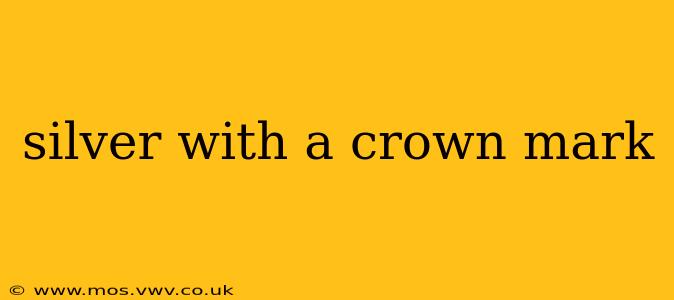Silver, a precious metal prized for its beauty and versatility, often bears hallmarks to indicate its purity and origin. One such hallmark, frequently encountered, is the crown. But what does a crown mark on silver actually mean? This comprehensive guide will help you decipher the meaning behind this regal symbol and learn how to identify and appreciate silver pieces bearing this mark.
What Does a Crown Mark on Silver Mean?
The crown mark on silver isn't a universal symbol with a single meaning. Instead, its significance varies depending on the country of origin and the specific design of the crown itself. It typically indicates the silver's purity or that it has been assayed and approved by a particular authority. In some cases, the crown might be combined with other markings, such as numbers or letters, which further refine its meaning.
What Countries Use a Crown Mark on Silver?
Several countries have historically or currently used a crown as part of their silver hallmarks. These include, but are not limited to:
-
United Kingdom: British silver hallmarks are complex and often include a crown, alongside other marks that denote the year of manufacture, the assay office location, and the maker's mark. The crown itself can vary slightly in style depending on the period.
-
Norway: Norwegian silver hallmarks frequently feature a crown, often alongside other identifying marks.
-
Denmark: Similar to Norway, Danish silver hallmarks can incorporate a crown as a key element.
-
Other European Countries: Many other European countries have utilized crowns in their silver hallmarks throughout history, so determining the origin will often require examining the complete hallmark.
How Can I Identify the Meaning of a Specific Crown Mark?
Identifying the precise meaning of a crown mark requires careful examination of the entire hallmark. Look for accompanying marks:
-
Letters: These often indicate the assay office location (e.g., London, Birmingham, Sheffield for British silver).
-
Numbers: These usually represent the year of manufacture or a specific standard of purity.
-
Other symbols: Different symbols might indicate the maker's mark or other relevant information.
To accurately interpret the meaning, you may need to consult hallmark dictionaries or websites specializing in silver identification. These resources typically provide detailed illustrations and explanations of various hallmarks, including those featuring crowns.
What is the Difference Between a Crown Mark and Other Silver Hallmarks?
A crown mark is only one part of a often-complex hallmark system. Other common marks include:
-
Standard Mark: Indicates the purity of the silver (e.g., sterling silver is typically 92.5% pure silver).
-
Maker's Mark: A unique symbol identifying the silversmith who crafted the piece.
-
Assay Office Mark: A mark indicating the location where the silver was assayed (tested for purity).
-
Date Letter: A letter representing the year of manufacture.
Understanding the interplay of all these marks is crucial for a complete understanding of your silver piece.
Are There Different Types of Crown Marks Used on Silver?
Yes, the style of the crown can differ based on the country, assay office, and period. Some crowns might be more ornate than others, and some may include additional elements like shields or other symbols.
Is a Crown Mark on Silver Important for Its Value?
The presence of a crown mark, when correctly identified, significantly adds to the value of a silver piece. It authenticates the piece, establishes its age and origin, and provides a sense of history. A properly identified hallmark adds to the provenance and therefore the desirability of the piece.
This guide offers a starting point for understanding the complexities of silver hallmarks featuring a crown. Remember, thorough research and consultation with experts might be necessary for accurate identification. Happy hunting!
